sábado, 30 de abril de 2022
viernes, 29 de abril de 2022
Cómo expresar opiniones en inglés

Gramática Inglesa - English Grammar - Recursos Educativos en inglés
Saber cómo expresar una opinión en inglés es muy útil en la vida cotidiana. A todos se nos pide con frecuencia que demos nuestra opinión en las conversaciones. Ya sea sobre la última serie que viste, el libro que leíste o cualquier otro tema de la vida diaria, podemos expresarnos -y lo hacemos- sobre cualquier cosa.
Por suerte es bastante sencillo, sólo hay que conocer algunas frases clave para empezar una frase de opinión.
Expresar una opinión en inglés
Con estas tres expresiones, puedes empezar a expresar tu opinión en la mayoría de las conversaciones:
- In my opinion… - En mi opinión...
- I think that… - Pienso que...
- I believe that… - Creo que...
I think that es uno de los más sencillos. I think that it’s true. I think that it’s not true. (Creo que es cierto.Creo que no es cierto).
Para decir que estamos de acuerdo, diríamos:
I agree. (Estoy de acuerdo) Recuerda: No se utiliza así: I am agree.
I disagree. No estoy de acuerdo.
Hay muchas otras muchas expresiones, por ejemplo:
- I consider that… - Considero que...
- As far as I’m concerned… En lo que a mí respecta...
- I must admit that… - Debo admitir que...
*** "According to" se corresponde con "Según". Se utiliza para citar fuentes. Por ejemplo, "According to the lawyer", "según este article", etc.
🔆 También te puede interesar:
- Uso de whose en inglés - Pronombres relativos
- Who, which y that - Pronombres Relativos en inglés
- Was going to - El futuro en el pasado
- DO y MAKE en inglés ¿Cuáles son las diferencias?
- Cuándo usar Since, For, Ago: ¿Cuáles son las diferencias?
- The Gerund - El gerundio en inglés
- El Imperativo en Inglés - Imperative
- El comparativo y el superlativo en inglés
- Preguntas con WH-Questions 01 - What, where, why, who
- Preguntas con WH-Questions 02 - When, Which, Whose, How
- Cómo expresar cantidades en inglés
- Adjectives - Los Adjetivos en Inglés
- Uso de some / any acompañando nombres contables/incontables
- Modal verbs - Verbos modales en inglés
- El tiempo futuro en inglés
- Present Perfect Progressive - Presente perfecto progresivo
- Present perfect - El presente perfecto inglés
- Pretérito progresivo o continuo en inglés
- Simple past - El pretérito o pasado simple en inglés
- Presente continuo - Forma Afirmativa - English grammar
- Presente continuo - Forma Negativa
- Puntuación en inglés - All about punctuation in English
- Los verbos Auxiliares en inglés - Auxiliary Verbs
- Verbos irregulares en inglés, la lista que debes conocer
- Cómo decir la fecha en inglés - How to say the date in English
- Construir frases simples - To build a simple sentence
- Nombres contables e incontables en inglés
- Presente continuo - Forma Interrogativa
- Cómo Preguntar y decir el precio en inglés
Was going to - El futuro en el pasado

"Sí, iba a hacer la comida, pero finalmente alguien me vino a visitar".
En esta frase "Iba a hacer la comida", es una acción planificada, una intención. Fue una pequeña frase en la que usaste el tiempo futuro en el pasado.
Ahora, lo que aprenderemos es a expresar el mismo tipo de frases en inglés, especialmente con Was going to.
Was going to y el tiempo futuro en el pasado
Podemos utilizar "was going to" para hablar del futuro a partir de un momento del pasado: cuando hablamos de cosas que estaban previstas o de intenciones:
I was going to visit our London house, but my train was delayed. - Iba a visitar nuestra casa de Londres, pero mi tren se retrasó.
*** Es la intención que está en el pasado y que ha cambiado. El tiempo al que se refiere la intención puede ser tanto en el futuro como en el pasado:
Tomorrow we were going to go to the cinema but our car has broken down. Mañana íbamos a ir al cine pero nuestro coche se ha estropeado.
On Monday I was going to meet Anna, but she didn't show up. El lunes iba a quedar con Anna, pero no apareció.
Esta estructura también se utiliza para explicar por qué no se ha producido un hecho, para pedir una disculpa, para explicar un cambio de proyecto, para explicar un contexto:
I was going to invite Anna tonight. Do you think it’s a good idea? - Iba a invitar a Anna esta noche. ¿Crees que es una buena idea?
Hello Anna, I was going to send you a message today, but I totally forgot. Hola Anna, iba a enviarte un mensaje hoy, pero se me olvidó por completo.
We were going to have breakfast together, but we decided to meet for lunch instead. Íbamos a desayunar juntos, pero decidimos reunirnos para almorzar.
Was going to es una forma fácil de recordar para expresar una intención que tenías, o una acción que habías planeado. Por supuesto, hay otras formas de hablar del futuro en el pasado (veremos dos de ellas a continuación), pero si sólo recuerdas Was going to, ya serás capaz de expresarte en la mayoría de las situaciones.
También podemos utilizar los tiempos perfectos con "going to" para expresar diferentes perspectivas en el pasado:
He has been going to clean the garage for months. I don’t think he ever will.
Hay otras estructuras que pueden utilizarse para hablar del futuro en el pasado. El pretérito continuo puede usarse para arreglos en el pasado:
I was meeting the lawyer at 5pm. He quedado con el abogado a las 17h.
En el estilo más formal, "was/were to" puede utilizarse para hablar de planes y acuerdos:
We were to hold a live interview this day, but some technical problems prevented us from doing so. Este día íbamos a realizar una entrevista en directo, pero algunos problemas técnicos nos lo impidieron.
🔆 También te puede interesar:
Uso de whose en inglés - Pronombres relativos
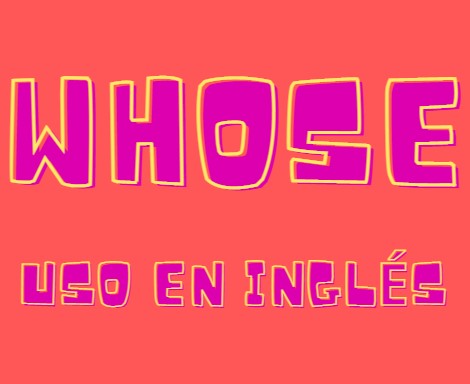
Gramática Inglesa - English Grammar - Recursos Educativos en inglés
Whose - Pronombres relativos en inglés
En este artículo, nos centraremos en el uso de whose en inglés. Te recomiendo que antes leas: Who, which y that - Pronombres Relativos en inglés
¿Cuándo utilizar el pronombre relativo whose?
Whose puede usarse como pronombre relativo y también para hacer una pregunta. Aquí sólo veremos whose como pronombre relativo. Si quieres utilizarlo para hacer una pregunta, puedes leerlo en Preguntas con WH-Questions 02 - When, Which, Whose, How.
Como pronombre relativo, whose se traduce como "cuyo". Whose indica una relación de pertenencia o parentesco.
The woman, whose cat is black, is my mother - La mujer, cuyo gato es negro, es mi madre.
WHOSE se utiliza como pronombre relativo en inglés, cuando conecta dos cosas (o personas) que están relacionadas por posesión, parentesco o pertenencia.
Características de whose como pronombre relativo
Whose debe ir seguido del sustantivo al que se refiere. No se pone un artículo o un sujeto, sino directamente el sustantivo (o grupo nominal).
Después de whose simplemente se pone el nombre.
A person whose father…
Sustituir "whose" por " of which" en algunos casos:
Para las cosas, se puede utilizar of which en lugar de whose. La mayor parte de las veces, esto se hace en el lenguaje escrito.
Cuando whose NO es un pronombre relativo: para hacer una pregunta
Cuando no se trata de un pronombre relativo, whose, when, where, why, etc., se utiliza para formular una pregunta. Para saber más sobre este tema, consulta ⇒ Preguntas con WH-Questions 01 - What, where, why, who y Preguntas con WH-Questions 02 - When, Which, Whose, How
🔆 También te puede interesar:
- Who, which y that - Pronombres Relativos en inglés
- Was going to - El futuro en el pasado
- DO y MAKE en inglés ¿Cuáles son las diferencias?
- Cuándo usar Since, For, Ago: ¿Cuáles son las diferencias?
- The Gerund - El gerundio en inglés
- El Imperativo en Inglés - Imperative
- El comparativo y el superlativo en inglés
- Preguntas con WH-Questions 01 - What, where, why, who
- Preguntas con WH-Questions 02 - When, Which, Whose, How
- Cómo expresar cantidades en inglés
- Adjectives - Los Adjetivos en Inglés
- Uso de some / any acompañando nombres contables/incontables
- Modal verbs - Verbos modales en inglés
- El tiempo futuro en inglés
- Present Perfect Progressive - Presente perfecto progresivo
- Present perfect - El presente perfecto inglés
- Pretérito progresivo o continuo en inglés
- Simple past - El pretérito o pasado simple en inglés
- Presente continuo - Forma Afirmativa - English grammar
- Presente continuo - Forma Negativa
- Puntuación en inglés - All about punctuation in English
- Los verbos Auxiliares en inglés - Auxiliary Verbs
- Verbos irregulares en inglés, la lista que debes conocer
- Cómo decir la fecha en inglés - How to say the date in English
- Construir frases simples - To build a simple sentence
- Nombres contables e incontables en inglés
- Presente continuo - Forma Interrogativa
- Cómo Preguntar y decir el precio en inglés
jueves, 28 de abril de 2022
Mommy - Mother's Day - Canciones para Niños en Inglés
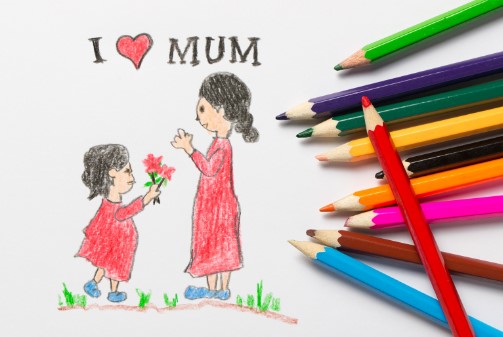
Canciones para Niños en Inglés: Día de la Madre - Songs for Children in English: Mother's Day
Mommy - Mother's Day Song for Kids
Mommy makes my day begin,
Letting all the sunshine in,
Always takes me to the park,
Holds my hand when it gets dark;
You're my Mommy, mine all mine,
Always making sure I shine;
Kissing, hugging, holding tight,
Teaching me what's wrong from right,
You're my Mommy, I'm so blessed,
I love you Mommy, you're the best.
Me and Mommy, we're a team!
She gives me the strength to dream.
Sings me every night to sleep
Wishing me her love to keep
You're my Mommy, mine all mine,
Always making sure I shine;
Kissing, hugging, holding tight,
Teaching me what's wrong from right,
You're my Mommy, I'm so blessed,
I love you Mommy, you're the best.
Canciones para niños en inglés para el día de la madre. Ideales para favorecer el aprendizaje del idioma, adquirir vocabulario, practicar la pronunciación, etc.
More Songs for Children in English: Mother's Day
Mother's Day Poems
On Mother's Day - Canciones para Niños en Inglés

Canciones para Niños en Inglés: Día de la Madre - Songs for Children in English: Mother's Day
On Mother's Day - Mother's Day Song for Kids
“I’ve got something special for Mother’s Day
To thank you for the love that you give me every day
It’s just a little heart, but it says all that I can say
And it’s just for you on Mother’s Day"
I put my hands together, this is how I start
I curve my fingers around so they make a heart
And I blow it like a kiss and I send it your way
And it’s just for you on Mother’s Day
I’ve got something special for Mother’s Day
To thank you for the love that you give me everyday
It’s just a little heart but it says all that I can say
And it’s just for you on Mother’s Day
And it’s just for you on Mother’s Day
Canciones para niños en inglés para el día de la madre. Ideales para favorecer el aprendizaje del idioma, adquirir vocabulario, practicar la pronunciación, etc.
More Songs for Children in English: Mother's Day
Mother's Day Poems
To My Mother - Lucretia Maria Davidson - Mother's Day Poems

Poesías en inglés día de la madre
Recursos Educativos en Inglés - Poems in English
To My Mother by Lucretia Maria Davidson
O thou whose care sustained my infant years,
And taught my prattling lip each note of love;
Whose soothing voice breathed comfort to my fears,
And round my brow hope’s brightest garland wove;
To thee my lay is due, the simple song,
Which Nature gave me at life’s opening day;
To thee these rude, these untaught strains belong,
Whose heart indulgent will not spurn my lay.
O say, amid this wilderness of life,
What bosom would have throbbed like thine for me?
Who would have smiled responsive?—who in grief,
Would e’er have felt, and, feeling, grieved like thee?
Who would have guarded, with a falcon-eye,
Each trembling footstep or each sport of fear?
Who would have marked my bosom bounding high,
And clasped me to her heart, with love’s bright tear?
Who would have hung around my sleepless couch,
And fanned, with anxious hand, my burning brow?
Who would have fondly pressed my fevered lip,
In all the agony of love and wo?
None but a mother—none but one like thee,
Whose bloom has faded in the midnight watch;
Whose eye, for me, has lost its witchery,
Whose form has felt disease’s mildew touch.
Yes, thou hast lighted me to health and life,
By the bright lustre of thy youthful bloom—
Yes, thou hast wept so oft o’er every grief,
That wo hath traced thy brow with marks of gloom.
O then, to thee, this rude and simple song,
Which breathes of thankfulness and love for thee,
To thee, my mother, shall this lay belong,
Whose life is spent in toil and care for me.
Thanks so much to Kako, for sending in this poem
More Mother's Day Poems
martes, 26 de abril de 2022
lunes, 25 de abril de 2022
DO y MAKE en inglés ¿Cuáles son las diferencias?

La diferencia entre Do y Make en inglés
A veces es difícil diferenciar entre Do y Make en inglés. De hecho, podemos traducir ambos por el verbo "hacer".
En este sentido, estos dos verbos son similares. Pero:
Do ⇒ Hacer en el sentido de actuar. Para "hacer" actividades, o cuando se habla de hacer algo en general.
Make ⇒ Hacer en el sentido de fabricar, crear, construir. (A menudo objetos palpables, que podemos tocar).
En general, Do se utiliza en los siguientes casos:
- Cuando alguien realiza una actividad o un trabajo, por ejemplo:
Do your bed.
Do your food.
Do the homework.
- Y cuando se habla de cosas en general, por ejemplo:
I’m not doing anything today.
I do sport with him.
**** Do también se utiliza de otra manera, como auxiliar. Por ejemplo, para hacer una pregunta (por ejemplo: ¿DO you want...?).
Make se utiliza con mayor frecuencia en los siguientes casos:
- Cuando se trata de construir, crear o fabricar. Ejemplos:
I'm making a cake.
To make hocolate.
Con Make, a menudo se pueden tocar los objetos en cuestión, se crea algo tangible.
Sin embargo, hay, por supuesto, excepciones y expresiones específicas. Por ejemplo:
Make a plan.
Make a suggestion.
Make the most of something.
🔆 También te puede interesar:
Modal verbs - Verbos modales en inglés

¿Qué son los verbos modales?
En inglés, los modales (plural de modal) no son palabras que deban interpretarse como si tuvieran un significado. Más que significar algo, los modales ingleses tienen una función.
Para hacer una comparación, tomemos la palabra -de-. por si sola no tiene ningún significado, porque es una palabra que tiene una función. En cambio, si digo "es la casa de Elena", entonces entendemos el significado de la palabra (la casa pertenece a Elena).
Lo mismo ocurre con los modales. Cada modalidad tiene una o varias funciones particulares.
Para entender los modales, primero haremos una lista de modales y explicaremos cómo se comportan en las frases: se comportan como auxiliares. Luego veremos qué funciones realizan.
Lista de verbos modales
Hay 9 modales:
- Can
- Could
- May
- Might
- Must
- Should
- Will
- Would
- Shall
Las tres peculiaridades de los modales
Cuando construyas una frase con un modal, debes respetar estas tres reglas:
1) Son invariables. Sea cual sea el tiempo de la frase, el sujeto de la misma, los modales se escribirán siempre de la misma manera. Por ejemplo:
I Could
You Could
He Could
We Could
You Could
They Could
Esto no debe confundirse con los verbos "normales" que llevan una S en la tercera persona del singular en tiempo presente (por ejemplo: she reads). Con los modales, siempre es igual.
2) Van seguidos de una base verbal. Es decir, un verbo, en infinitivo, sin el TO delante. Por ejemplo:
I can call you the monday. Puedo llamarte el lunes.
No se utiliza "To call". Solo CALL.
Esta base verbal también es invariable. No cambia, sea cual sea el sujeto.
3) Se comportan como auxiliares (porque SON auxiliares) en oraciones negativas e interrogativas. Así que no necesitas los auxiliares DO, HAVE o BE.
Esto significa que nunca dirás "I don’t may". Dirás "I may not". Del mismo modo, al hacer una pregunta, nunca dirás "¿Do you will...?", sino que dirás "¿Will you...?".
Esta es la lista de formas negativas de los modales:
- May - may not
- Might - might not
- Can - can’t o cannot
- Could - couldn’t o could not
- Must - mustn’t o must not
- Should - shouldn’t o should not
- Will - won’t o will not
- Would - wouldn’t o would not
Para las formas interrogativas, simplemente se invierte el sujeto y el modal.
I will - will you…?
I might - might I…?
I can - can you…?
¿Qué funciones tiene cada modalidad?
Los modales pueden tener una o varias funciones según el contexto. Aquí tienes un resumen general.
May
Forma afirmativa: expresa la probabilidad
Lo que puede ocurrir: It may snow again tomorrow. Puede que mañana vuelva a nevar.
Lo que puede ser cierto: What you’re saying may be true. Lo que dices puede ser cierto.
También puede expresar permiso: You may eat now. Ya puedes comer.
Forma negativa: May not
Lo que no puede ocurrir.
Lo que puede no ser cierto.
También puede expresar una prohibición categórica. You may not eat here. No se puede comer aquí.
Forma interrogativa: May I…?
En una pregunta, may se utiliza para pedir permiso, pero de una forma aún más educada que con can y could. - May I eat here?
Might
Forma afirmativa:
El modal Might es un sinónimo de may. What you’re saying might be true. Lo que dices puede ser cierto.
Forma negativa:
Might not.
Forma interrogativa:
Una petición aún más educada que con MAY (raramente se ve).
Can
Forma afirmativa:
Lo que uno es capaz de hacer: I can read this book. Puedo leer este libro (soy capaz).
Lo que está permitido: I can go out tomorrow. Puedo salir mañana (se me permite).
Forma negativa:
Cannot o can't.
Lo que no puedes hacer.
Lo que está prohibido.
Forma interrogativa:
Can I…?
Pedir permiso o hacer una petición. Dad, can I go to the theater tomorrow? - Papá, ¿puedo ir al teatro mañana?
Could
Forma afirmativa:
Lo que uno podría hacer: If I had a pool, I could swim. Si tuviera una piscina, podría nadar.
Qué podría pasar si...
Could también puede ser el tiempo pasado de - can -.I could see you. Te pude ver.
Forma negativa
Could not o couldn’t
Similar a la forma afirmativa. I couldn't see you. No pude verte.
Forma interrogativa:
Pedir un favor o un permiso de forma educada. Could you help me?
Must
Forma afirmativa:
El modal Must transmite un deber, una obligación. Lo que debes hacer.- I must clean my house today. Hoy debo limpiar mi casa.
Must también puede expresar una certeza. It must be half past five. - Sin duda, deben ser las 5 y media.
Forma negativa:
Mustn't o must not.
Esta forma expresa una prohibición.
Should:
Forma afirmativa:
El modal should expresa un deber, como must, pero con menos fuerza. Se utiliza para expresar lo que se debe hacer. A menudo se utiliza para dar consejos. (ej.: You must read more - Debes leer más).
Forma negativa:
Should't o should not
El mismo significado que la forma afirmativa. You shouldn't go out today - No deberías salir hoy.
Forma interrogativa:
Should I…?
Will:
Forma afirmativa :
Expresión del tiempo futuro: Como ver en la lección sobre el tiempo futuro en inglés, el modal will se utiliza principalmente para expresar el futuro. (Como el tiempo futuro no existe como tiempo gramatical en inglés, se construye con el modal will).
Ejemplos: I will be 30 next month. El mes que viene cumpliré 30 años.
También se suele utilizar la forma contraída de will: "ll. - I'll be 30 next month.
Will también puede expresar la voluntad o la toma de decisiones.
Forma negativa:
Will not o won't.
Expresar el futuro.
Puede utilizarse para expresar una prohibición. Dad won't let me go out. Papá no me deja salir.
Forma interrogativa:
Para pedir un favor, por ejemplo. Will you help me?
Would
La función principal del modal sería expresar el condicional.
Ejemplos: It would be cool to meet Italy. Sería genial conocer Italia.
I wouldn’t want to travel to Italy. No me gustaría viajar a Italia.
También se utiliza la forma contraída en 'D: It’d be cool to meet Italy.
Shall:
Ya casi no se utiliza. Sólo se utiliza para hacer sugerencias, normalmente en forma interrogativa:
Ejemplo: ¿Tomamos un taxi? ¿Tomamos un taxi?
En el inglés británico shall también puede usarse como el equivalente en tercera persona del singular de will, aunque esta forma se ve raramente hoy en día.
-
🔆 También te puede interesar:
- Cómo preguntar y expresar la posesión en inglés
- Cómo usar May y might - Verbos modales
- Conditionals in English - El condicional en Inglés
- Adjetivos y pronombres demostrativos en Inglés
- Pronombres Posesivos en inglés - Possessive Pronouns
- Adjetivos Posesivos en Inglés - Possessive adjectives
- ¿Cómo aprender inglés fácil y desde casa?
- Plural de los sustantivos en inglés
- Many more, a lot more y Much more. Usos en inglés
- ¿Qué son los phrasal verbs en inglés? Los más usados
- Cómo expresar opiniones en inglés
- Uso de whose en inglés - Pronombres relativos
- Who, which y that - Pronombres Relativos en inglés
- Was going to - El futuro en el pasado
- DO y MAKE en inglés ¿Cuáles son las diferencias?
- Cuándo usar Since, For, Ago: ¿Cuáles son las diferencias?
- The Gerund - El gerundio en inglés
- El Imperativo en Inglés - Imperative
- El comparativo y el superlativo en inglés
- Preguntas con WH-Questions 01 - What, where, why, who
- Preguntas con WH-Questions 02 - When, Which, Whose, How
- Cómo expresar cantidades en inglés
- Adjectives - Los Adjetivos en Inglés
- Uso de some / any acompañando nombres contables/incontables
- Modal verbs - Verbos modales en inglés
- El tiempo futuro en inglés
- Present Perfect Progressive - Presente perfecto progresivo
- Present perfect - El presente perfecto inglés
- Pretérito progresivo o continuo en inglés
- Simple past - El pretérito o pasado simple en inglés
- Presente continuo - Forma Afirmativa - English grammar
- Presente continuo - Forma Negativa
- Puntuación en inglés - All about punctuation in English
- Los verbos Auxiliares en inglés - Auxiliary Verbs
- Verbos irregulares en inglés, la lista que debes conocer
- Cómo decir la fecha en inglés - How to say the date in English
- Construir frases simples - To build a simple sentence
- Nombres contables e incontables en inglés
- Presente continuo - Forma Interrogativa
- Cómo Preguntar y decir el precio en inglés
El tiempo futuro en inglés

El tiempo futuro no es un tiempo gramatical en inglés. Este tiempo no existe como tal en la lengua inglesa, pero se construye con diferentes palabras. Por ejemplo con WILL, que es la forma más común de expresar el futuro. También hay que ir a por el futuro inmediato. A veces incluso utilizamos el tiempo presente para hablar del futuro. Por ejemplo: What are you doing tomorrow?
Will
Construcción:
La palabra will es un modal. Es la palabra más común para hablar en tiempo futuro. Una frase en tiempo futuro con will se construye de la siguiente manera:
Sujeto + WILL + Base Verbal.
I will cook for lunch. Voy a cocinar para el almuerzo.
Después de WILL, como después de todos los modales, los verbos son INVARIABLES, y nunca se poneTO.
Forma negativa :
I will not cook for lunch.
I won’t cook for lunch. (forma contraída).
Forma interrogativa:
La voluntad toma el papel de auxiliar, por lo que no son necesarios los auxiliares hacer, tener o ser.
Will you cook for lunch?
¿Cuándo se usa?
Will se utiliza para hablar de un futuro casi seguro (por ejemplo: I will be 30 next year).
También se utiliza para enfatizar la expresión de la voluntad. Implica que la decisión se acaba de tomar. (Si la decisión es anterior al momento de hablar, no se suele usar).
Ejemplo: I will have an ice coffe. Tomaré un café con hielo.
Be going to + Verbo
I am going to write. - Voy a escribir.
I am going to run soon. - Voy a correr pronto.
También se utiliza para hacer predicciones basadas en pistas presentes. Por ejemplo: Be careful, you’re going to burnt! - ¡Ten cuidado, te vas a quemar!
Por último, se utiliza cuando la decisión se ha tomado antes del momento de hablar (a diferencia de la voluntad, que se utiliza para expresar una decisión que se acaba de tomar). Por ejemplo: I am going to take a coffee cup.
Por último, be going to + verbo puede utilizarse cuando se da una orden, o se utiliza una forma de autoridad.
Now you’re going to get in the bus and leave this village as soon as you can. Ahora vas a subir al autobús y dejar este pueblo tan pronto como puedas.
Ten en cuenta que en el lenguaje coloquial, going to se dice a veces gonna. Por ejemplo: You’re gonna go - o - you gonna go.
Otras formas de hablar en el futuro:
A veces se utiliza el presente para hablar en futuro.
Ejemplo: The train arrives today at 5pm. El barco llega hoy a las 17 horas.
Hablar de una acción que realmente está a punto de ocurrir.
Hello? Good morning Cris, I was just about to call you! - Hola? Buenos días Cris, ¡estaba a punto de llamarte!
🔆 También te puede interesar:
- Cómo preguntar y expresar la posesión en inglés
- Cómo usar May y might - Verbos modales
- Conditionals in English - El condicional en Inglés
- Adjetivos y pronombres demostrativos en Inglés
- Pronombres Posesivos en inglés - Possessive Pronouns
- Adjetivos Posesivos en Inglés - Possessive adjectives
- ¿Cómo aprender inglés fácil y desde casa?
- Plural de los sustantivos en inglés
- Many more, a lot more y Much more. Usos en inglés
- ¿Qué son los phrasal verbs en inglés? Los más usados
- Cómo expresar opiniones en inglés
- Uso de whose en inglés - Pronombres relativos
- Who, which y that - Pronombres Relativos en inglés
- Was going to - El futuro en el pasado
- DO y MAKE en inglés ¿Cuáles son las diferencias?
- Cuándo usar Since, For, Ago: ¿Cuáles son las diferencias?
- The Gerund - El gerundio en inglés
- El Imperativo en Inglés - Imperative
- El comparativo y el superlativo en inglés
- Preguntas con WH-Questions 01 - What, where, why, who
- Preguntas con WH-Questions 02 - When, Which, Whose, How
- Cómo expresar cantidades en inglés
- Adjectives - Los Adjetivos en Inglés
- Uso de some / any acompañando nombres contables/incontables
- Modal verbs - Verbos modales en inglés
- El tiempo futuro en inglés
- Present Perfect Progressive - Presente perfecto progresivo
- Present perfect - El presente perfecto inglés
- Pretérito progresivo o continuo en inglés
- Simple past - El pretérito o pasado simple en inglés
- Presente continuo - Forma Afirmativa - English grammar
- Presente continuo - Forma Negativa
- Puntuación en inglés - All about punctuation in English
- Los verbos Auxiliares en inglés - Auxiliary Verbs
- Verbos irregulares en inglés, la lista que debes conocer
- Cómo decir la fecha en inglés - How to say the date in English
- Construir frases simples - To build a simple sentence
- Nombres contables e incontables en inglés
- Presente continuo - Forma Interrogativa
- Cómo Preguntar y decir el precio en inglés
viernes, 22 de abril de 2022
21 phrasal verbs más comunes en inglés!

Hola, espero que estés bien. En este blogpost te quiero compartir los 21 phrasal verbs más comunes en inglés que en mi experiencia tanto aprendiendo ingles como enseñando, debes saber para alcanzar un nivel más avanzado del idioma inglés.
Mira el video en youtube y si te gusta el contenido dale like y suscribete!
Poems Of Ella Wheeler Wilcox - Poemas en inglés
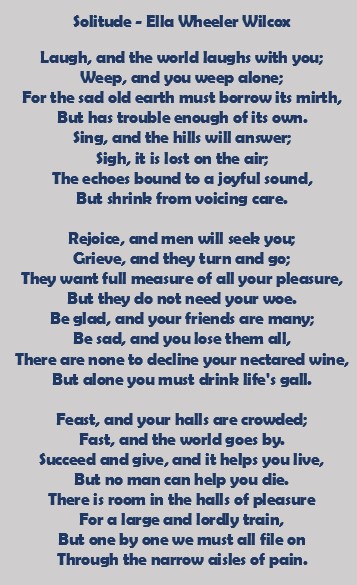
Recursos Educativos en Inglés - Poems in English - Poesías en inglés
I Love You - Ella Wheeler Wilcox
I love your lips when they’re wet with wine
And red with a wild desire;
I love your eyes when the lovelight lies
Lit with a passionate fire.
I love your arms when the warm white flesh
Touches mine in a fond embrace;
I love your hair when the strands enmesh
Your kisses against my face.
Not for me the cold, calm kiss
Of a virgin’s bloodless love;
Not for me the saint’s white bliss,
Nor the heart of a spotless dove.
But give me the love that so freely gives
And laughs at the whole world’s blame,
With your body so young and warm in my arms,
It sets my poor heart aflame.
So kiss me sweet with your warm wet mouth,
Still fragrant with ruby wine,
And say with a fervor born of the South
That your body and soul are mine.
Clasp me close in your warm young arms,
While the pale stars shine above,
And we’ll live our whole young lives away
In the joys of a living love.
A Naughty Little Comet - Ella Wheeler Wilcox
There was a little comet who lived near the Milky Way!
She loved to wander out at night and jump about and play.
The mother of the comet was a very good old star;
She used to scold her reckless child for venturing out too far.
She told her of the ogre, Sun, who loved on stars to sup,
And who asked no better pastime than in gobbling comets up.
But instead of growing cautious and of showing proper fear,
The foolish little comet edged up nearer, and more near.
She switched her saucy tail along right where the Sun could see,
And flirted with old Mars, and was as bold as bold could be.
She laughed to scorn the quiet stars who never frisked about;
She said there was no fun in life unless you ventured out.
She liked to make the planets stare, and wished no better mirth
Than just to see the telescopes aimed at her from the Earth.
She wondered how so many stars could mope through nights and days,
And let the sickly faced old Moon get all the love and praise.
And as she talked and tossed her head and switched her shining trail
The staid old mother star grew sad, her cheek grew wan and pale.
For she had lived there in the skies a million years or more,
And she had heard gay comets talk in just this way before.
And by and by there came an end to this gay comet's fun.
She went a tiny bit too far-and vanished in the Sun!
No more she swings her shining trail before the whole world's sight,
But quiet stars she laughed to scorn are twinkling every night.
Life's Scars - Ella Wheeler Wilcox
They say the world is round, and yet
I often think it square,
So many little hurts we get
From corners here and there.
But one great truth in life I've found,
While journeying to the West-
The only folks who really wound
Are those we love the best.
The man you thoroughly despise
Can rouse your wrath, 'tis true;
Annoyance in your heart will rise
At things mere strangers do;
But those are only passing ills;
This rule all lives will prove;
The rankling wound which aches and thrills
Is dealt by hands we love.
The choicest garb, the sweetest grace,
Are oft to strangers shown;
The careless mien, the frowning face,
Are given to our own.
We flatter those we scarcely know,
We please the fleeting guest,
And deal full many a thoughtless blow
To those who love us best.
Love does not grow on every tree,
Nor true hearts yearly bloom.
Alas for those who only see
This cut across a tomb!
But, soon or late, the fact grows plain
To all through sorrow's test:
The only folks who give us pain
Are those we love the best.
The Little White Hearse - Ella Wheeler Wilcox
Somebody's baby was buried to-day
The empty white hearse from the grave rumbled back,
And the morning somehow seemed less smiling and gay
As I paused on the walk while it crossed on its way,
And a shadow seemed drawn o'er the sun's golden track.
Somebody's baby was laid out to rest,
White as a snowdrop, and fair to behold,
And the soft little hands were crossed over the breast,
And those hands and the lips and the eyelids were pressed
With kisses as hot as the eyelids were cold.
Somebody saw it go out of her sight,
Under the coffin lid--out through the door;
Somebody finds only darkness and blight
All through the glory of summer-sun light;
Somebody's baby will waken no more.
Somebody's sorrow is making me weep:
I know not her name, but I echo her cry,
For the dearly bought baby she longed so to keep,
The baby that rode to its long-lasting sleep
In the little white hearse that went rumbling by.
I know not her name, but her sorrow I know;
While I paused on the crossing I lived it once more,
And back to my heart surged that river of woe
That but in the breast of a mother can flow;
For the little white hearse has been, too, at my door.
🔆 Read more Poems
Poems Of Elizabeth Bishop - Poemas en inglés
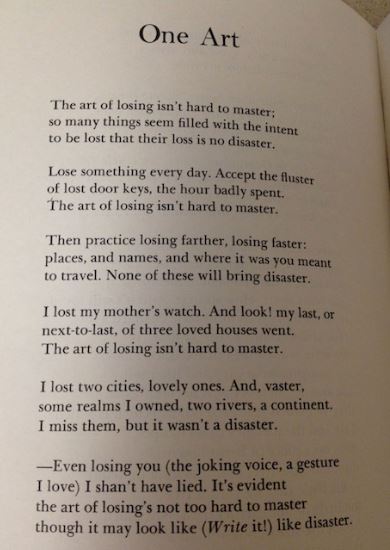
Recursos Educativos en Inglés - Poems in English - Poesías en inglés
One Art - Elizabeth Bishop
The art of losing isn’t hard to master;
so many things seem filled with the intent
to be lost that their loss is no disaster.
Lose something every day. Accept the fluster
of lost door keys, the hour badly spent.
The art of losing isn’t hard to master.
Then practice losing farther, losing faster:
places, and names, and where it was you meant
to travel. None of these will bring disaster.
I lost my mother’s watch. And look! my last, or
next-to-last, of three loved houses went.
The art of losing isn’t hard to master.
I lost two cities, lovely ones. And, vaster,
some realms I owned, two rivers, a continent.
I miss them, but it wasn’t a disaster.
—Even losing you (the joking voice, a gesture
I love) I shan’t have lied. It’s evident
the art of losing’s not too hard to master
though it may look like (Write it!) like disaster.
The Fish - Elizabeth Bishop
I caught a tremendous fish
and held him beside the boat
half out of water, with my hook
fast in a corner of his mouth.
He didn’t fight.
He hadn’t fought at all.
He hung a grunting weight,
battered and venerable
and homely. Here and there
his brown skin hung in strips
like ancient wallpaper,
and its pattern of darker brown
was like wallpaper:
shapes like full-blown roses
stained and lost through age.
He was speckled with barnacles,
fine rosettes of lime,
and infested
with tiny white sea-lice,
and underneath two or three
rags of green weed hung down.
While his gills were breathing in
the terrible oxygen
—the frightening gills,
fresh and crisp with blood,
that can cut so badly—
I thought of the coarse white flesh
packed in like feathers,
the big bones and the little bones,
the dramatic reds and blacks
of his shiny entrails,
and the pink swim-bladder
like a big peony.
I looked into his eyes
which were far larger than mine
but shallower, and yellowed,
the irises backed and packed
with tarnished tinfoil
seen through the lenses
of old scratched isinglass.
They shifted a little, but not
to return my stare.
—It was more like the tipping
of an object toward the light.
I admired his sullen face,
the mechanism of his jaw,
and then I saw
that from his lower lip
—if you could call it a lip—
grim, wet, and weaponlike,
hung five old pieces of fish-line,
or four and a wire leader
with the swivel still attached,
with all their five big hooks
grown firmly in his mouth.
A green line, frayed at the end
where he broke it, two heavier lines,
and a fine black thread
still crimped from the strain and snap
when it broke and he got away.
Like medals with their ribbons
frayed and wavering,
a five-haired beard of wisdom
trailing from his aching jaw.
I stared and stared
and victory filled up
the little rented boat,
from the pool of bilge
where oil had spread a rainbow
around the rusted engine
to the bailer rusted orange,
the sun-cracked thwarts,
the oarlocks on their strings,
the gunnels—until everything
was rainbow, rainbow, rainbow!
And I let the fish go.
🔆 Read more Poems
Poems Of Edwin Arlington Robinson - Poemas en inglés
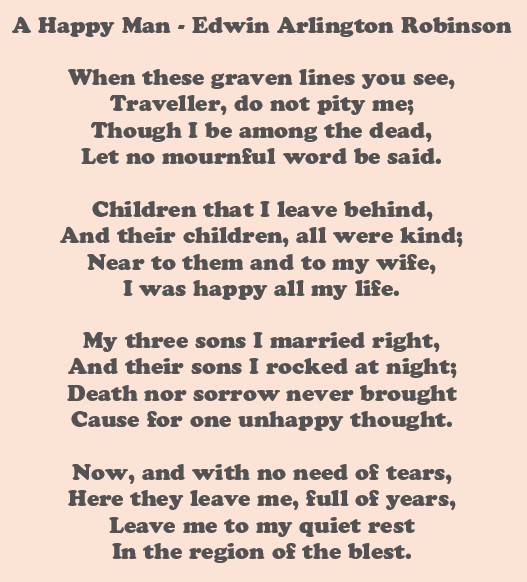
Recursos Educativos en Inglés - Poems in English - Poesías en inglés
Richard Cory - Edwin Arlington Robinson
Whenever Richard Cory went down town,
We people on the pavement looked at him:
He was a gentleman from sole to crown,
Clean favored, and imperially slim.
And he was always quietly arrayed,
And he was always human when he talked;
But still he fluttered pulses when he said,
"Good-morning," and he glittered when he walked.
And he was rich - yes, richer than a king -
And admirably schooled in every grace:
In fine, we thought that he was everything
To make us wish that we were in his place.
So on we worked, and waited for the light,
And went without the meat, and cursed the bread;
And Richard Cory, one calm summer night,
Went home and put a bullet through his head.
A Happy Man - Edwin Arlington Robinson
When these graven lines you see,
Traveller, do not pity me;
Though I be among the dead,
Let no mournful word be said.
Children that I leave behind,
And their children, all were kind;
Near to them and to my wife,
I was happy all my life.
My three sons I married right,
And their sons I rocked at night;
Death nor sorrow never brought
Cause for one unhappy thought.
Now, and with no need of tears,
Here they leave me, full of years,--
Leave me to my quiet rest
In the region of the blest.
🔆 Read more Poems
martes, 19 de abril de 2022
House and family - Usos del lenguaje, Gramática y Léxico

Iniciación al inglés – Repaso de conceptos para conversaciones básicas
Presentaciones
- Presentación informal:
Hello! My name’s (nombre). This is (nombre) and this is (nombre).
- Presentación formal:
How do you do! (Encantado/a)
How do you do! (Mucho gusto!
Saludos
- No confundir el saludo:
How are you? ¿Cómo estás? / ¿Cómo está usted?
- Al que se responde:
Fine, thanks or very well, thank you.
- Con la presentación:
How do you do!
A la que se responde con la misma frase. (How do you do!).
Despedidas
- Diferentes formas de decir adiós.
Good-bye / Bye for now / See you son!
En la calle
- Cuando se interrumpe a alguien o se pide ayuda a un desconocido, se usa:
Excuse me! (¡Perdone! ¡Oiga!
Al teléfono
Cuando hablamos por teléfono, usamos THIS para identificarnos a nosotros mismos y THAT para preguntar quién es la otra persona. Para indicar que somos la persona con la que se desea hablar, empleamos: SPEAKING.
Mr., Mrs., Miss
Mr.: El señor… (Seguido del nombre y apellido, o sólo apellido).
Mrs.: La señora de… (Seguido de nombre y apellido, o sólo apellido).
Miss: Señorita, o la señorita… (Seguido de nombre y apellido, o sólo apellido).
Ms.: Forma abreviada de “señora” (Mrs.) o “señorita” (Miss) (En lenguaje escrito).
Mr., Mrs., Miss… no llevan artículo.
La gente, las personas
“People” tiene ambos significados, pero se usa siempre con el verbo en plural y sin artículo, cuando se habla en forma general.
Una persona – one person.
Dos personas – two people.
La ciudad
- Town y city.
La palabra city significa en su sentido más estricto “ciudad con catedral”, pero se usa normalmente al hablar de grandes ciudades. Town se usa al hablar de ciudades más pequeñas o pueblos grandes.
Formación del plural
- Regla general: se añade una (s) al singular. Ejemplo: flat / flats; book / books.
Cuando las palabras terminan en sh, ch, ss, se le añade (es). Glass / glasses.
Las palabras terminadas en consonante + y, pierden la (y) y añaden (ies). Country / countries.
Las palabras terminadas en (fe), cambian la (f) por (v) y añaden (es). Housewife / housewives.
En inglés no se usa el masculino plural de un nombre para indicar los dos sexos. Hay una palabra especial o se menciona los dos.
Ejemplos:
Parents: Father and mother.
Schoolchildren: Schoolboy and schoolgirl.
Brothers (sólo hombres) and sisters (sólo mujeres): Hermanos en general.
Mr. And Mrs. White: Los señores White (el señor y la señora).
Artículos
El artículo indeterminado, THE, a veces se omite en inglés, aunque se use en español. Por ejemplo cuando se habla en general:
Los perros y los gatos no son amigos. Dogs and cats aren’t friends.
Adjetivos
- Calificativos
Cuando dos adjetivos acompañan al nombre no van unidos por la conjunción AND, sino que se colocan uno a continuación del otro. Sin embargo, los colores cuando funcionan como adjetivos sí que llevan la conjunción AND, aunque vayan junto al nombre:
Ese vestido rojo y negro es muy bonito. That red black dress is very pretty.
Concuerdan siempre con el poseedor.
I – my
You – your
He – his
She – her
It – its
We – our
They – their
Para formar decenas y unidades, entre el 21 y el 99, no se usa la conjunción (and), sino que se unen con un guión: (29) twenty-nine.
Para indicar los cientos, basta poner el número y la palabra (hundred), que es invariable. (100) a hundred / one hundred. (200) two hundred.
Los cientos se unen a las decenas con la conjunción AND. (135) a hundred and thirty-five.
- Demostrativos
Se usan también como pronombres.
Plural de this – THESE – éstos, éstas.
Plural de that – THOSE – ésos, ésas; aquéllos, aquéllas.
- Indefinidos
Indican una cantidad de la que no sabemos número, peso o medida exactos.
ANY – algunos, algunas, ninguno. Se usa en negaciones y también en preguntas. Su significado varía y a veces no tiene traducción.
Are there any dogs in the Street? No, there aren’t any.
Preposiciones
La preposición (en) tiene tres formas en inglés:
- In: en, dentro de. Se usa para hablar de una ciudad o país y, en general, cuando hablamos de cosas que tienen tres dimensiones: In Madrid; in the kitchen.
- On: en, sobre. Generalmente se usa con superficies (playa, montaña) on the beach, y además, para situar y localizar: On the right; on the left.
- At: en, posición en un punto determinado. At the party; at home.
La preposición (de), tiene dos formas:
- Of: de (indica posesión). Se usa especialmente cuando se trata de cosas. The garden of the house – El jardín de la casa. The capital of Spain – La capital de España.
- From: de,desde (indica origen, procedencia…) Where are you from? ¿De dónde eres? (la preposición va al fianl). It´s a hundred metres from here – Está a cien metros de aquí.
Adverbios
Como en español, acompañan al verbo, a un adjetivo o a otro adverbio y son invariables:
Near: cerca, cerca de… No lleva preposición.
Far: lejos. Cuando acompaña a un nombre, lleva la preposición (De) far from – lejos de. No suele usarse en frases afirmativas.
Verbos
- Presente de BE.
Este verbo tiene distintos significados en español, entre ellos HABER (impersonal), cuyo sujeto en inglés, es THERE. Tiene dos formas:
There is – hay, para el singular. Indica una sola persona, animal o cosa.
There are – hay, para el plural. Indica más de una persona, animal o cosa.
Para formar preguntas: verbo + sujeto+ complemento + ?
Para formar negaciones: se añade (not) al verbo.
Las respuestas breves tienen el mismo sujeto: Yes, there ies / No, there isn’t.
- Presente de HAVE GOT
El verbo have got (tener), tiene en presente dos formas distintas: have y has.
Pertenece también a los llamados verbos especiales.
Las negaciones se forman añadiendo not al verbo.
Las preguntas se forman invirtiendo el orden normal de la frase: Verbo + sujeto + complementos + ?
En la conversación se usa siempre la forma contraída. No es fácil confundirlo con el verbo BE porque generalmente va acompañado del GOT. En caso de duda, hay que guiarse por el sentido de la frase.
La respuesta breve se forma con YES o NO, el sujeto (siempre en forma de pronombre) y el verbo sin (got). La respuesta breve afirmativa no se puede contraer; la negativa, sí.
Yes, I have / No, I haven’t
Yes, he has / No, he hasn’t
🔆 También te puede interesar:
- Cómo preguntar y expresar la posesión en inglés
- Cómo usar May y might - Verbos modales
- Conditionals in English - El condicional en Inglés
- Adjetivos y pronombres demostrativos en Inglés
- Pronombres Posesivos en inglés - Possessive Pronouns
- Adjetivos Posesivos en Inglés - Possessive adjectives
- ¿Cómo aprender inglés fácil y desde casa?
- Plural de los sustantivos en inglés
- Many more, a lot more y Much more. Usos en inglés
- ¿Qué son los phrasal verbs en inglés? Los más usados
- Cómo expresar opiniones en inglés
- Uso de whose en inglés - Pronombres relativos
- Who, which y that - Pronombres Relativos en inglés
- Was going to - El futuro en el pasado
- DO y MAKE en inglés ¿Cuáles son las diferencias?
- Cuándo usar Since, For, Ago: ¿Cuáles son las diferencias?
- The Gerund - El gerundio en inglés
- El Imperativo en Inglés - Imperative
- El comparativo y el superlativo en inglés
- Preguntas con WH-Questions 01 - What, where, why, who
- Preguntas con WH-Questions 02 - When, Which, Whose, How
- Cómo expresar cantidades en inglés
- Adjectives - Los Adjetivos en Inglés
- Uso de some / any acompañando nombres contables/incontables
- Modal verbs - Verbos modales en inglés
- El tiempo futuro en inglés
- Present Perfect Progressive - Presente perfecto progresivo
- Present perfect - El presente perfecto inglés
- Pretérito progresivo o continuo en inglés
- Simple past - El pretérito o pasado simple en inglés
- Presente continuo - Forma Afirmativa - English grammar
- Presente continuo - Forma Negativa
- Puntuación en inglés - All about punctuation in English
- Los verbos Auxiliares en inglés - Auxiliary Verbs
- Verbos irregulares en inglés, la lista que debes conocer
- Cómo decir la fecha en inglés - How to say the date in English
- Construir frases simples - To build a simple sentence
- Nombres contables e incontables en inglés
- Presente continuo - Forma Interrogativa
- Cómo Preguntar y decir el precio en inglés
Poems Of Abbie Farwell Brown - Poemas en inglés
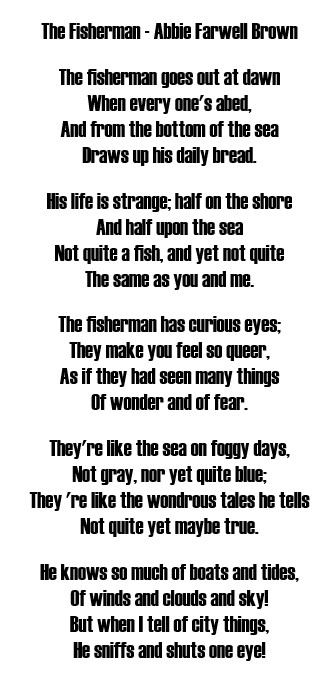
Recursos Educativos en Inglés - Poems in English - Poesías en inglés
Friends - Abbie Farwell Brown
How good to lie a little while
And look up through the tree!
The Sky is like a kind big smile
Bent sweetly over me.
The Sunshine flickers through the lace
Of leaves above my head,
And kisses me upon the face
Like Mother, before bed.
The Wind comes stealing o'er the grass
To whisper pretty things;
And though I cannot see him pass,
I feel his careful wings.
So many gentle Friends are near
Whom one can scarcely see,
A child should never feel a fear,
Wherever he may be.
The Fisherman - Abbie Farwell Brown
The fisherman goes out at dawn
When every one's abed,
And from the bottom of the sea
Draws up his daily bread.
His life is strange ; half on the shore
And half upon the sea
Not quite a fish, and yet not quite
The same as you and me.
The fisherman has curious eyes;
They make you feel so queer,
As if they had seen many things
Of wonder and of fear.
They're like the sea on foggy days,
Not gray, nor yet quite blue;
They 're like the wondrous tales he tells
Not quite yet maybe true.
He knows so much of boats and tides,
Of winds and clouds and sky!
But when I tell of city things,
He sniffs and shuts one eye!
🔆 Read more Poems
lunes, 18 de abril de 2022
Aprender inglés rápido es posible con estos pasos!

Aprender inglés puede ser un desafío, pero te ayudará a alcanzar tus metas. Con las herramientas digitales adecuadas y con cierta determinación, aprender inglés podría convertirse en una parte cotidiana de tu vida.
Esta publicación de blog es para aquellos de ustedes que están interesados en mejorar sus habilidades en inglés con solo unas pocas horas al día.
Hoy en día, tienes diferentes formas de aprender inglés, que van más allá de ir a clases y si aplicas estas técnicas para aprender inglés, lo podrás hacer en mucho menos tiempo, aquí te comparto 3 actividades que puedes hacer cada día que te van a ayudar a aprender inglés en mucho menos tiempo.
Aprende a escuchar y entender el idioma inglés.
Dedicate a ver programas y películas y series en Inglés todo el tiempo (SIN
SUBTÍTULOS). Al principio, se te va a hacer difícil y aburrido, pero llegará un
momento en que te vas a dar cuenta que comienza a tener sentido y empiezas a
Entender la trama y reconocer expresiones.
Llegará el momento en que aunque no entiendas todas las palabras, podrías entender perfectamente el sentido de todas las conversaciones en inglés.
El segundo paso es, Aprender a leer y escribir en inglés.
La manera más fácil es conversando en chats o por e-mail con personas de habla
inglesa. Desde luego, no aprenderás el mejor inglés ni con la mejor redacción y
ortografía, pero aprenderás a conversar rápidamente sobre temas superficiales.
Escribe en foros. Consigue amigos en el extranjero y pide que te escriban
diariamente por e-mail y contesta sus e-mails también en inglés. Incluso puedes
pedirles que te ayuden a corregir tus faltas.
Y tercer y último paso es Conversar, practica conversación lo mas que puedas:
Esta es la parte más difícil. Si no vives cerca o viajas continuamente a
En lugares donde solo se habla Inglés, es difícil practicar. Lo que puedes hacer es
tratar de conseguir amigos extranjeros y hacer videollamadas o conversaciones
por teléfono, hasta puedes hablar solo frente al espejo, la idea en realidad es
que tu boca y tu lengua se adapten al ritmo del idioma inglés.
¿Qué te parecen estos tips? ¿Crees que lo puedes aplicar?
Deja un comentario y dinos si puedes aplicar estos pasos. Hasta pronto!
Si estás comprometido con tu proceso de aprendizaje del idioma inglés y aún tienes dudas con temas de gramática, vocabulario o tips en general para aprender inglés, te recomiendo escuchar nuestro podcast, ENGLISHWAYRD, en este podcast los conductores, Thomas martinez y starlin santos (Yo) abordamos todos los temas en relación al aprendizaje del idioma inglés, de forma divertida y fácil de entender. Escucha el podcast en tu app de podcast favorita.
Suscribete en: Apple podcast / Spotify / Google podcast
Síguenos en las redes sociales:
Únete a una comunidad con tus mismo intereses y practica tu inglés.
Desde los inicios de los tiempos los seres humanos hemos necesitado la comunidad para fortalecernos y crecer juntos y eso no ha cambiado, el ser humano es un ser social y la socialización en torno a un tema de interés común te ayudara a aprender mas rápido, es por esto que te recomiendo que busques una comunidad con tus mismos intereses para que puedas practicar tu inglés, socializar, aprender y compartir lo que sabes, eso de verdad que ayuda mucho.
En EnglishwayRD creemos que la comunidad es importante para el aprendizaje y por eso tenemos nuestro club de inglés en Whatsapp. Únete y comparte y aprende en comunidad.

Conoce a los presentadores del podcast

Starlin santos
Co-fundador de englishwayrd, host del podcast englishwayrd. Profesor de ingles con mas de 5 años de experiencia en la enseñanza del idioma inglés. TEFL certified.

Thomas martinez
Co-fundador de englishwayrd, host del podcast englishwayrd. Profesor de inglés certificado con 4 años de experiencia en la enseñanza del idioma ingles y mas de 1o años en el aprendizaje de inglés. TEFL certified.
Past perfect - El pasado perfecto o pluscuamperfecto

El pasado perfecto o pretérito pluscuamperfecto en inglés
El pasado perfecto, también llamado pluscuamperfecto, es un tiempo pasado que se construye con el auxiliar HAVE. Su construcción es bastante similar a la del presente perfecto, excepto que aquí se utiliza HAD (HAVE en el pretérito) + participio pasado.
Construcción del pasado perfecto en inglés
La construcción de este tiempo es, por tanto, : HAD + participio pasado
Louise had told us not to be late. Louise nos había dicho que no llegáramos tarde.
Somebody had left the window open. Alguien había dejado la ventana abierta.
If I had known, I wouldn’t have come. Si lo hubiera sabido, no habría venido.
¿Cuándo se usa?
El pasado perfecto expresa una conexión entre un momento del pasado y otro momento aún más lejano. Es el "pasado en el pasado".
Es una especie de "tiempo pasado de la narración", que se utiliza cuando toda la historia está en tiempo pasado y se quiere hablar de una acción aún más en el pasado.
Por ejemplo:
Last month, my mother wasn't at home, so I organised a party with my colleagues. My mother HAD TOLD me not to invite colleagues at home, but I didn’t care, and I invited them anyway. - El mes pasado, mi madre no estaba en casa, así que organicé una fiesta con mis amigos. Mi madre me dijo que no invitara a mis amigos, pero no me importó y los invité de todos modos.
“My mother had told me…” es una acción que tuvo lugar más allá de la organización de la fiesta. Por lo tanto, se utiliza el pasado perfecto.
Otro ejemplo: He said that he had never been so happier. - Dijo que nunca había sido tan feliz.
Ten en cuenta que el pasado perfecto no es el tiempo pasado más utilizado en inglés. A diferencia del pretérito y el presente perfecto, se puede mantener una conversación básica sin saberlo de memoria.
🔆 También te puede interesar:
- Cómo preguntar y expresar la posesión en inglés
- Cómo usar May y might - Verbos modales
- Conditionals in English - El condicional en Inglés
- Adjetivos y pronombres demostrativos en Inglés
- Pronombres Posesivos en inglés - Possessive Pronouns
- Adjetivos Posesivos en Inglés - Possessive adjectives
- ¿Cómo aprender inglés fácil y desde casa?
- Plural de los sustantivos en inglés
- Many more, a lot more y Much more. Usos en inglés
- ¿Qué son los phrasal verbs en inglés? Los más usados
- Cómo expresar opiniones en inglés
- Uso de whose en inglés - Pronombres relativos
- Who, which y that - Pronombres Relativos en inglés
- Was going to - El futuro en el pasado
- DO y MAKE en inglés ¿Cuáles son las diferencias?
- Cuándo usar Since, For, Ago: ¿Cuáles son las diferencias?
- The Gerund - El gerundio en inglés
- El Imperativo en Inglés - Imperative
- El comparativo y el superlativo en inglés
- Preguntas con WH-Questions 01 - What, where, why, who
- Preguntas con WH-Questions 02 - When, Which, Whose, How
- Cómo expresar cantidades en inglés
- Adjectives - Los Adjetivos en Inglés
- Uso de some / any acompañando nombres contables/incontables
- Modal verbs - Verbos modales en inglés
- El tiempo futuro en inglés
- Present Perfect Progressive - Presente perfecto progresivo
- Present perfect - El presente perfecto inglés
- Pretérito progresivo o continuo en inglés
- Simple past - El pretérito o pasado simple en inglés
- Presente continuo - Forma Afirmativa - English grammar
- Presente continuo - Forma Negativa
- Puntuación en inglés - All about punctuation in English
- Los verbos Auxiliares en inglés - Auxiliary Verbs
- Verbos irregulares en inglés, la lista que debes conocer
- Cómo decir la fecha en inglés - How to say the date in English
- Construir frases simples - To build a simple sentence
- Nombres contables e incontables en inglés
- Presente continuo - Forma Interrogativa
- Cómo Preguntar y decir el precio en inglés
Present Perfect Progressive - Presente perfecto progresivo

El presente perfecto progresivo o continuo en inglés
El presente perfecto progresivo, o continuo, es un tiempo pasado en inglés, que se forma con el auxiliar to be (en el tiempo presente perfecto) + el verbo terminado en ING. Se utiliza para enfatizar la duración de una acción. ¿Cómo construirlo y cómo utilizarlo?
¿Cómo se construye el presente perfecto progresivo?
BE (presente perfecto) + ING
Después de haber visto el tiempo presente, pudimos ver que hay un tiempo presente continuo en BE + ING.
Después de haber visto el pretérito, pudimos ver que hay un pretérito continuo en BE (pretérito) + ING.
I have been waiting for four hours. Llevo cuatro horas esperando.
Have been= auxiliar BE en el presente perfecto
Waiting = verbo WAIT, esperar, + ING.
¿Qué significa exactamente poner una frase en presente perfecto progresivo?
Ejemplo:
He (drive) for one day. ⇒ He has been driving for one day. - Lleva un día conduciendo.
They (read) until now. ⇒ They have been reading until now. - Han estado leyendo hasta ahora.
Cómo utilizar el presente perfecto progresivo
Al igual que el presente perfecto, se utiliza para hablar de una acción que tiene un vínculo entre el pasado y el presente. De hecho, el presente perfecto progresivo sigue siendo una forma de presente perfecto.
Su principal diferencia con el presente perfecto normal es que se utiliza más para enfatizar la duración de la acción o la acción en sí misma, mientras que en el presente perfecto queremos ver los resultados de la acción. Esto queda en el ámbito del matiz en comparación con el presente perfecto, así que con un ejemplo, seguramente será más claro:
Si yo digo:
I have cleaned my car (presente perfecto normal). Esto significa que acabo de limpiar mi coche y ahora el resultado visible es que mi coche está limpio. El presente perfecto se centra en el resultado.
Ahora, si digo la misma frase en la forma progresiva:
I have been cleaning my car. (presente perfecto progresivo). Esto significa que he pasado mucho tiempo limpiando mi coche. Por eso solemos añadir una duración, como aquí: for three hours]. Lo que quiero decir no es necesariamente que mi coche está limpio, sino que he pasado mucho tiempo limpiándolo. Así que no estamos seguros de que haya terminado de limpiar mi coche, pero sí de que he pasado algún tiempo haciéndolo.
🔆 También te puede interesar:
- Cómo preguntar y expresar la posesión en inglés
- Cómo usar May y might - Verbos modales
- Conditionals in English - El condicional en Inglés
- Adjetivos y pronombres demostrativos en Inglés
- Pronombres Posesivos en inglés - Possessive Pronouns
- Adjetivos Posesivos en Inglés - Possessive adjectives
- ¿Cómo aprender inglés fácil y desde casa?
- Plural de los sustantivos en inglés
- Many more, a lot more y Much more. Usos en inglés
- ¿Qué son los phrasal verbs en inglés? Los más usados
- Cómo expresar opiniones en inglés
- Uso de whose en inglés - Pronombres relativos
- Who, which y that - Pronombres Relativos en inglés
- Was going to - El futuro en el pasado
- DO y MAKE en inglés ¿Cuáles son las diferencias?
- Cuándo usar Since, For, Ago: ¿Cuáles son las diferencias?
- The Gerund - El gerundio en inglés
- El Imperativo en Inglés - Imperative
- El comparativo y el superlativo en inglés
- Preguntas con WH-Questions 01 - What, where, why, who
- Preguntas con WH-Questions 02 - When, Which, Whose, How
- Cómo expresar cantidades en inglés
- Adjectives - Los Adjetivos en Inglés
- Uso de some / any acompañando nombres contables/incontables
- Modal verbs - Verbos modales en inglés
- El tiempo futuro en inglés
- Present Perfect Progressive - Presente perfecto progresivo
- Present perfect - El presente perfecto inglés
- Pretérito progresivo o continuo en inglés
- Simple past - El pretérito o pasado simple en inglés
- Presente continuo - Forma Afirmativa - English grammar
- Presente continuo - Forma Negativa
- Puntuación en inglés - All about punctuation in English
- Los verbos Auxiliares en inglés - Auxiliary Verbs
- Verbos irregulares en inglés, la lista que debes conocer
- Cómo decir la fecha en inglés - How to say the date in English
- Construir frases simples - To build a simple sentence
- Nombres contables e incontables en inglés
- Presente continuo - Forma Interrogativa
- Cómo Preguntar y decir el precio en inglés
Present perfect - El presente perfecto inglés

En inglés hay un tiempo extraño, a medio camino entre el presente y el pasado... ¡Lo que necesitas saber sobre el presente perfecto inglés!
El presente perfecto es un tiempo pasado que se utiliza a menudo en inglés. Se construye con el auxiliar HAVE y el participio pasado. Se utiliza principalmente para hablar de una acción pasada relacionada con el presente, como una declaración, o una acción que podemos ver la continuidad en el presente.
A continuación te contamos: Cómo construir el presente perfecto y cómo utilizarlo.
Present perfect - ¿Cómo se construye el presente perfecto en inglés?
HAVE + participio pasado
Por ejemplo:
I have drunk all the water. He bebido toda el agua.
He has influenced my decision. Ha influido en mi decisión.
A veces, sobre todo en el discurso, se utilizan contracciones. Siguiendo con los dos ejemplos anteriores, se obtiene :
I’ve drunk all the water.
He’s influenced my decision.
Atención: nos damos cuenta de que suena un poco como is del verbo to be.
He is cool / He’s cool. Él es genial, verbo to be. He’s taken a Kiss Cool
‘s taken significa has taken. Así que ten cuidado de no confundirlos. Cuando hay un participio pasado después de la 's, es el presente perfecto y el auxiliar HAVE en la tercera persona: HAS.
El participio pasado:
En consecuencia, es necesario conocer el participio pasado de los verbos: para los verbos regulares, es sencillo, sólo hay que añadir ED al final del verbo, es lo mismo que para el pretérito. Para los verbos irregulares, en cambio, tendrás que aprenderlos uno a uno con la ayuda de una lista de verbos irregulares. Tomemos por ejemplo el verbo SEE (ver) en el pretérito da SAW y en el participio pasado da SEEN. Así que no puedes adivinarlos, tienes que aprenderlos. Lista de verbos irregulares en inglés
Present perfect - ¿Cómo se utiliza el presente perfecto en inglés?
El presente perfecto se utiliza para hablar de una acción que acaba de ocurrir recientemente, o de una acción pasada que podemos ver un vínculo con el presente (como en una declaración de hecho, por ejemplo). Como su nombre indica, el presente perfecto siempre tiene la idea de una continuidad o un vínculo, aunque sea sutil, con el presente.
Por ejemplo, si digo:
Oh! I’ve lost my book!
Esto implica que ahora veo que lo he perdido. La acción de haberlo perdido está en el pasado, pero la observación de esto es ahora, en el presente. Si tomo el mismo ejemplo en tiempo pretérito para ver la diferencia, sería:
I lost my book yesterday. Ayer perdí mi libro. (Pretérito)
Aquí, hay un marcador de tiempo muy específico, ayer, por lo que ya ha pasado un tiempo desde que lo notamos, es una acción pasada en el pasado.
El presente perfecto también se utiliza para hablar de tu experiencia vital en general, sin entrar en detalles. Por ejemplo, si alguien te dice
I have been through many troubles in my life. He pasado por muchos problemas en mi vida.
Aquí tienes que usar el presente perfecto, porque estás hablando de tu experiencia de forma general, sin entrar en detalles.
¿Cómo diferenciar el pretérito del presente perfecto?
Para decidir, pregúntate lo siguiente: ¿es una acción pasada? ¿Hay un marcador de tiempo? Si es así ⇒ pretérito.
Pregúntate también: ¿hay un vínculo con el presente? ¿Es una observación, un estado presente resultante de una acción pasada? ¿Se trata de una experiencia vital que se cuenta? Si la respuesta es sí a alguna de estas preguntas ⇒ presente perfecto.
Por otra parte, hay una serie de palabras que conducen necesariamente al presente perfecto. Estas palabras son :
Ever, already, yet, just…
Cuando veas estas palabras en un ejercicio, sabrás que es el presente perfecto lo que tienes que utilizar.
🔆 También te puede interesar:
sábado, 16 de abril de 2022
5 Little Easter Eggs - Easter Songs for Kids

Canciones para Niños en Inglés: Pascua, Semana santa - Songs for Children in English: Easter
5 Little Easter Eggs
Five little Easter eggs, lovely colors wore
Mother ate the blue one, then there were four
Four little Easter eggs, two and two you see
Daddy ate the red one, then there were three
Three little Easter eggs, before I knew
Sister ate the yellow one, then there were two
Two little Easter egg, Oh what fun
Brother ate the purple one, then there was one
One little Easter egg, see me run
I ate the last one, and then there were none!
Happy Easter Day.
Recursos en inglés para Pascua Semana Santa ⇓
I Want Candy - Easter Songs for Kids

Canciones para Niños en Inglés: Pascua, Semana santa - Songs for Children in English: Easter
I Want Candy
I know a guy who’s tough but sweet
He’s so fine, he can’t be beat
He’s got everything that I desire
Sets the summer sun on fire
I want candy, I want candy
Go to see him when the sun goes down
Ain’t no finer boy in town
You’re my guy, just what the doctor ordered
So sweet, you make my mouth water
I want candy, I want candy
Candy on the beach, there’s nothing better
But I like candy when it’s wrapped in a sweater
Some day soon I’ll make you mine,
Then I’ll have candy all the time
I want candy, I want candy
I want candy, I want candy
Happy Easter Day.
Recursos en inglés para Pascua Semana Santa ⇓
Mister Rabbit - Easter Songs for Kids

Canciones para Niños en Inglés: Pascua, Semana santa - Songs for Children in English: Easter
Mister Rabbit
Mister rabbit mister rabbit
your coat is mighty grey
yes, my friend, I like it that way
every little soul must shine
every little soul must shine
Mister rabbit mister rabbit
your tails mighty white
better to see me in the cool black night
every little soul must shine
every little soul must shine
Mister rabbit mister rabbit
Your ears are mighty fluffy
Yes, my friend, I’m a tough little bunny
every little soul must shine
every little soul must shine
Mister rabbit mister rabbit
your hoppin legs are long
yes my friend now sing your song
every little soul must shine
every little soul must shine
every little soul must shine
every little soul must shine
Happy Easter Day.
Recursos en inglés para Pascua Semana Santa ⇓
viernes, 15 de abril de 2022
Easter - Pascua en inglés - Banco de Recursos

Pascua - Easter Celebraciones - Celebrations
Recursos y materiales gratis en inglés, para Pascua - Easter.
Easter: the Christian story of Easter
The Christian festival of Easter is the celebration of the resurrection of Jesus Christ. In the early days of Christianity, Christian Easter coincided with the Jewish Easter. At that time the calendar used to fix the date of Easter was the Jewish or Babylonian calendar. The resurrection of Jesus Christ fell on the 14th day of Nissan at the same time as Pesach, the Jewish Passover.
The Council of Nicaea in 325 and the beginning of the differences
Constantine I convened the Council of Nicaea in 325 where it was decided that all Christians would celebrate Easter on the first Sunday after the full moon following the spring equinox. To avoid confusion with the Jewish festival, Easter was to be shifted by one week in years when the equinox corresponded to Pesach.
Alexandria wanted to keep the date of 14 Nissan as Easter, while Rome wanted Easter to fall on a Sunday, regardless of the Babylonian calendar. This also made it possible to clearly distinguish Christian Easter from Passover.
In practice, the shifts of the Julian calendar with the solar and lunar year did not allow the Christians to respect the terms of the council. The date of Easter varied according to the regions of the world. On several occasions, Rome tried to reform the method of calculating the date of Easter, but each time it met with resistance from certain churches, such as the Church of Ireland.
It was not until the reform of the Gregorian calendar that a new common rule was adopted around 1582.
The calculation of the date of Easter remains a complex one, since Easter falls on the first Sunday after the first full ecclesiastical moon in spring. In addition, Easter must fall between 22 March and 25 April.
The highlights of Easter for Christians
The Easter period is marked by several highlights for Christians which are Lent, Palm Sunday, Good Friday and Easter Sunday.
Lent :
Preparations for Easter begin at the end of Shrove Tuesday with Ash Wednesday, which marks the beginning of Lent. On Ash Wednesday, Christians go to church for the distribution of Ashes. It is a day of self-examination and repentance. Ashes remind us that man is dust and will return to dust.
Lent was strictly observed until the beginning of the 20th century. For 40 days, equivalent to the 40 days spent by Jesus Christ in the desert, Christians follow a half fast during which certain rich and meaty foods are forbidden. The period of Lent is a time of purification and spiritual elevation in preparation for the resurrection of Jesus Christ.
Palm Sunday:
Palm Sunday precedes Easter Sunday and celebrates the arrival of Jesus in Jerusalem. Jesus was celebrated on his arrival, with people spreading palm branches under his feet as a carpet.
On Palm Sunday, Christians have branches of palm, boxwood or yew blessed, which are supposed to protect them from evil throughout the year. These branches are often decorated with sugar or marzipan decorations. In English-speaking countries this is called Willow, Yew or Blossom Sunday.
Good Friday
Good Friday is a very important day in the Christian religion, but also a very sad one as it commemorates the crucifixion of Christ.
Good Friday is the Friday after Palm Sunday, the day Jesus Christ died on the cross. It is the saddest and darkest day in Christianity. Therefore, Christians all over the world follow the Way of the Cross of Jesus Christ. Each station is an opportunity to recall an important stage of his ordeal and to pray.
Easter Sunday:
Easter Day celebrates the resurrection of Jesus Christ. It is the day when Jesus' disciples went to his tomb to find it empty. On their way back they met the risen Jesus and began to spread the good news.
Easter is a day of celebration and joy. All the prohibitions of Lent are lifted on this day. The Easter period is called the Paschal season. Traditionally, the Paschal lamb is eaten on Easter Day.
Where does the custom of Easter eggs come from?
From the simple coloured hard-boiled egg to the most prestigious Fabergé eggs, the Easter egg has remained a tradition throughout the world. In Italy, Easter eggs are still blessed and placed in the centre of the table. Russian and Ukrainian Easter eggs are real works of art, with very symbolic and geometric designs and colours, with Christian representations such as the cross and Christ himself.
In the West, in the countryside or in the gardens of the city house, a mysterious egg hunt is organised in the early hours of Easter morning. According to tradition, on their way back from Rome, the bells, which have been silent since Maundy Thursday evening, spread eggs, bells, casseroles and other delicacies. The custom of giving chocolate eggs or bunnies is of commercial origin.
The German tradition is to hide them in an invisible white rabbit for children. In the United States and Alsace, it is a hare; in Thuringia, a stork; in Westphalia, a fox; in Switzerland, a cuckoo.
Ancient origins
The custom of giving decorated, dyed or worked eggs existed long before the Christian era. As spring is the season of nature's blossoming, the egg, representing life and rebirth, was probably the first symbol used in rituals dating back to ancient times. In spring, the Egyptians and Persians used to dye eggs and offer them as a symbol of the renewal of life. In ancient Gaul, the druids dyed eggs red in honour of the sun.
For the Jews, the egg is the symbol of life but also of death. The liberation of the Hebrew people cost many lives, and happiness is never absolute for the Hebrews. At Passover, Jews dip an egg in salt water in memory of all the tears shed after the loss of their independence.
A Christian custom
Many pagan festivals therefore celebrated the resurrection of nature symbolised by the egg, the bearer of a life-giving seed. But it was most probably the Church's ban on eating eggs during Lent until the 17th century that gave rise to the Easter egg tradition. As the hens could not be prevented from laying eggs, they were carefully kept until Easter, when the stock had to be sold!
